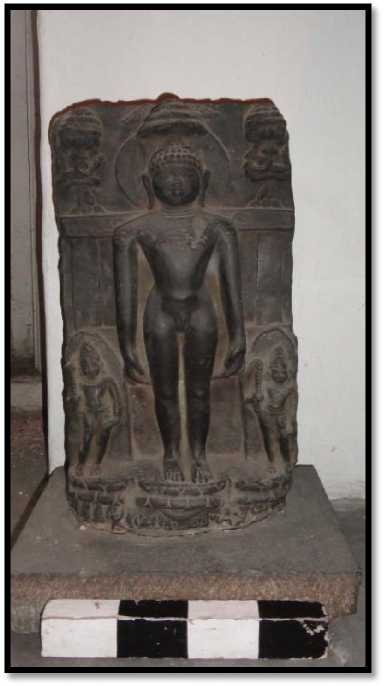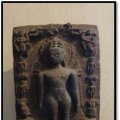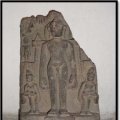Jain Remains of Ancient Bengal: photo 55
Photo 55 of 333 in Gallery: Jain Remains of Ancient Bengal

Image title: Number 7: Tirthankara Candraprabhu
Description of the photo
This is the image of Tirthankara Candraprabhu. The Jina stands in kayotsarga pose on a double-petalled lotus placed on a panca-ratha pedestal. The half moon lanchana is neatly carved on the centre of the pedestal along with two devotees kneeling in namaskara-mudra. A circular plain shirashcakra adorns the head of the savior. Above the shirashcakra is the depiction of a trilinear chatra flanked by two vidyadharas holding long garlands. The Jina is flanked on both sides by stout male cauri-bearers. They are wearing deeply incised loin cloths and elaborate jewellery and both of them have plain oval shaped halos. Obviously, the modulation of surfaces apparent from the drapery and jewellery are restricted to these parikara elements. These cauri-bearers stand on lotus pedestals and their left hands are in katyavalambita posture and the right hands hold a fly-whisk. It is made of black basalt and measures 40.5 x 21 x 7 cm. On stylistic consideration, the image is assignable to circa 11th–12th centuries CE.
Gallery information:
These photographs accompany the study on Jain Remains of Ancient Bengal based on the fields of Archaeology, Art and Iconography. Jainism represents a way of life incorporating non-violence and approaches religion from humanitarian viewpoint. Ancient Bengal represents the modern state of West Bengal and the Republic of Bangladesh, situated in the eastern part of the Indian sub-continent. Here, Jainism was allowed to flourish from the pre-Christian times up until the 10th century CE, along with Buddhism.
Photo details:
High resolution:
Download file
Size: 23.82 KB
Resolution: 384 x 686
© Copyright: see gallery source

